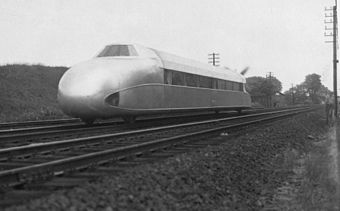Schienenzeppelin
| Schienenzeppelin | |
|---|---|

Schienenzeppelin at Erkrath-Hochdahl steep ramp
|
|

Rear view, showing the two-bladed propeller
|
|
| Manufacturer | Franz Kruckenberg |
| Built at | Hannover-Leinhausen (DR) |
| Constructed | 1929 |
| Scrapped | 1939 |
| Number built | 1 |
| Capacity | 40 |
| Specifications | |
| Car body construction | aluminum |
| Car length | 25.85 m (84 ft 9 3⁄4 in) |
| Height | 2.8 m (9 ft 2 1⁄4 in) |
| Maximum speed | 230 km/h (140 mph) |
| Weight | 20.3 t (20.0 long tons; 22.4 short tons) |
| Prime mover(s) | BMW VI |
| Engine type | Water-cooled V12 petrol aircraft engine |
| Cylinder count | 12 |
| Cylinder size | 160 mm × 190 mm (6.30 in × 7.48 in) 160 mm × 199 mm (6.30 in × 7.83 in) right bank / left bank |
| Power output | 600 hp (450 kW) |
| Transmission | compressed air (driving a propeller) |
| UIC classification | 2 |
| Track gauge | 1,435 mm (4 ft 8 1⁄2 in) standard gauge |
The Schienenzeppelin or rail zeppelin was an experimental railcar which resembled a zeppelin airship in appearance. It was designed and developed by the German aircraft engineer Franz Kruckenberg in 1929. Propulsion was by means of a propeller located at the rear: it accelerated the railcar to 230.2 km/h (143 mph) setting the land speed record for a petrol powered rail vehicle. Only a single example was ever built, which due to safety concerns remained out of service and was finally dismantled in 1939.
Anticipating the design of the Schienenzeppelin, the earlier Aerowagon, an experimental Russian high-speed railcar, was also equipped with an aircraft engine and a propeller.
The railcar was built at the beginning of 1930 in the Hannover-Leinhausen works of the German Imperial Railway Company (Deutsche Reichsbahn). The work was completed by autumn of the same year. The vehicle was 25.85 metres (84 ft 9 3⁄4 in) long and had just two axles, with a wheelbase of 19.6 metres (64 ft 3 5⁄8 in). The height was 2.8 metres (9 ft 2 1⁄4 in). As originally built it had two conjoined BMW IV 6-cylinder petrol aircraft engines (later a single BMW VI 12-cylinder of 600 horsepower (450 kW)) driving a four-bladed (later two-bladed), fixed pitch ash propeller. The driveshaft was raised 7 degrees above the horizontal to give the vehicle some downwards thrust. The body of the Schienenzeppelin was streamlined, having some resemblance to the era's popular Zeppelin airships, and it was built of aluminum in aircraft style to reduce weight. The railcar could carry up to 40 passengers; its interior was spartan and designed in Bauhaus-style.
...
Wikipedia
